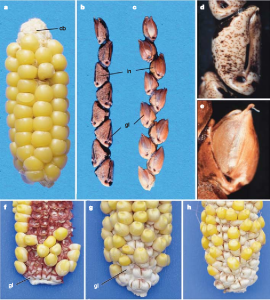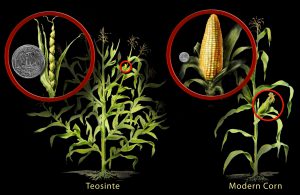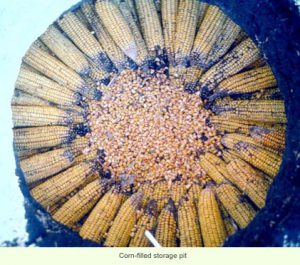Have you ever heard of “Indian Corn”? All corn is “Indian Corn”. The Native Americans discovered a way to make the corn they had more edible and bountiful, to feed a vast majority economically. Corn started out as a black big, almost pointy and hard kernels called Teosinte. (NativeTech)
Photo Credit: Nicolle Rager Fuller, National Science Foundation
According to the National Science Foundation, in 2005, a scientist in California, Brandon Gaut, helped to make this process more visible by recreating it. He did exactly what the Native Americans did around 10,000 years ago. The scientists took a Teosinte plant, which was only 2-3 inches long and produced about 5 to 12 kernels, which were very hard and mostly for animals to eat. When early botanist found this plant, the scientists quickly dismissed how it could be related to modern corn. Especially when our modern corn is about 12 inches long, and 500 or more kernels. (National Science Foundation, 2005)

Here is a chart of the corn broken down to show the differences. The picture has a chart at the bottom that describes it in scientific terms. The first photo is what we know Maize (corn) to be today. The picture (B) is the grass seed Teosinte ear that has the rachis internode (in) and glume (gl) labelled. The picture ( C) is one of the first cultivations of maize and teosinte. The picture (d) is the actual closeup of the teosinte fruitcase. The picture (e) is a closeup of the cultivation between the maize and the teosinte. The next three pictures at the bottom of the chart (f,g,h), show us what the tesonite glumes and internodes look like in the corn after all the cultivations.
Wang, H.H., Nussbaum-Wagler, T., Li, B., Zhao, Q., Vigouroux, Y., Faller, M., Bomblies, K., Lukens, L., & Doebley, J. (2005). The origin of the naked grains of maize. Nature, 436, 714-719.
Although scientists cannot say how long this cultivation process took. There is some archaeological evidence about how the corn plant completely lost its genetic diversity, which would mean a domestication event. The scientists from the National Science Foundation, believe that it took around 3,500 teosinte plants to create the modern corn. They figured out from this experiment that it took about 1,000 genes from the Teosinte plant to create the corn. (National Science Foundation, 2005) During this cultivation process, corn lost its survival ability in the wild.
The cultivation process softened the kernel up and infused it into the cob more. The new corn gained larger ears with more rows of soft kernels. (NativeTech) There is some archaeology that shows this cultivation happened about 6,000 years ago. Archaeology has shown that Argiculture is around 9,000 – 10,000 years old. Archaeologists have found the domestication event of corn to be between 6,000 and 10,000 years old in central Mexico. (NativeTech)
Image Credit:
Wendy and Michael Scullin
UI-OSA Photo Archives
Native Americans made over 250 different kinds of corn, all different colors. (Hilarie, Larry, 1)Maybe these different kinds of corn are just what happened during different cultivations? Did the Natives like them enough to eat?
Further Reading
Follow the “Three Sisters Method” for planting
https://homeguides.sfgate.com/native-american-method-growing-corn-69787.html
WOW! You can eat the colored “Indian Corn”
http://eatyourwayclean.com/can-you-eat-indian-corn-yes-and-heres-how/
“Indian Corn and edible?”
https://recipes.howstuffworks.com/everything-about-indian-corn.htm



Really like your article! Such an interesting topic. I liked the portion where you talked about how through experimental growing, archaeologists were able to understand the process of domestication. How does experimental archaeology help us understand how corn was cultivated? What are some flaws/downsides to these approaches?
Glad you enjoyed it!
Experimental archaeology is the probably the only way we can actually see the change in cultivation take place. As a society and world culture, “learning by doing” or “hand-on learning” seems to be the easiest way to help new things make sense to us. Being that modern corn is cultivated from a plant that doesn’t look very similar, a “hands-on” approach would help it make sense much easier.
R.J. Silva from Desert Archaeology Inc. helps us to understand how the experimental archaeology works. While the team was constructing a pithouse, in order to find out certain aspects of the Natives of Las Capas, Jim Vint and Fred Nials also made a garden. Jim Vint discovered that the garden could feed 46 to 111 people per year. (Silva, R.J.)
The article by R.J. Silva, also talks about how good and bad things can come from experimental archaeology. We are able to experience what problems would arise from these tasks and how to overcome the challenges. Maybe even how many different challenges that come about and what resources were available at the time in order to help solve the problem. For instance, every single time the maize would bloom, the person would have to check it to see if it produced enough of the “fruit”. Otherwise, they would’ve dug up the plant and only planted the ones that had bigger “fruits” and less branches.
Upon further investigation and an article from Bringham Young University, scientists have found the “grassy tillers” that was once the teosinte. Clinton Whipple, figured out that the Native Americans continued to replant the seeds of the plants that produced the fewer branches and larger ears of the maize.(Bringham Young University) A big thank you to Native Americans for their persistence and eye for this twig to become a bountiful vegetable. Especially one that fed so many people and continues to today.
Reference list
Silva, R.J. (2017, January 6). Experimental Archaeology: Learning by doing. Desert Archaeology Inc.
https://desert.com/experimental-archaeology-learning/
Bringham Young University (2011, August, 10) How corn came to be. Phys.Org
https://phys.org/news/2011-08-corn.html